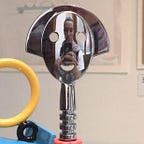ITP Camp 2021 Part II
June 7, 2021 — June 9th, 2021
I started off Monday watching a session that took place Saturday and was recorded for later viewing. I’ve been doing that a lot because I can never make it to the sessions on time either because I work a day job or I forget the session is ongoing.
In this session ITP Professor Kari Love gave a 30-minute talk on religious robots. In her talk Kari gave various examples of robots used within religious ceremonies, robots embodying goddesses, robots used to teach religion and some other religion adjacent robots. One of these religion adjacent robots is Sophia, a robot who was granted Saudi citizenship. In her talk, Kari highlighted that Sophia’s citizenship brought up questions about Sophia’s religion since non Muslims cannot be citizens of Saudi Arabia. In addition, Kari also asked if Sophia, having a female figure, would have to abide by the same rights given to women in Saudi Arabia?
What I thought was most interesting about the talk are the questions that “religious” robots in varying contexts can bring. Robots really stand out to us in an environment where they aren’t top of mind or typically thought to be associated in. However, they are perfect agents for creating a new perspective to question things.
Some robots that caught my attention:
Torah writing robot, shabbat goy robots.
The shabbat goy robot in particular resurfaced thoughts I always had about the Jewish laws of keeping the sabbath. Growing up and going to Jewish day school I learned that on the sabbath, or shabbat, (starting from sundown on Friday till sundown on Saturday) orthodox Jews do not implicitly use electricity. This is one of the many rules that encapsulates the experience of shabbat. However, those who observe shabbat often are still using electricity throughout the day of rest. People turn lights on before Friday evening only to turn them off after shabbat is over. Others make use of preprogrammed timers. Some make use of bedside lights that can be covered by twisting a cover on top of the bulb that will block the light to “turn it off” (but not really ;)). I’ve even ridden on elevators that are programmed to stop on every floor on shabbat, so one can ride it without pressing any buttons. These are fascinating work arounds, but their acceptance of use varies from person to person, or community to community.
I remember one of the most contested methods of using electricity on shabbat was using the help of what people called a shabbat goy. A shabbat goy, is a non Jewish person who performs some kind of work (like turning on lights) on shabbat for someone who is observing the day of rest. Sometimes this could a friend, a neighbor or even an employee. During this talk I learned that the list of possible shabbat goys has grown longer and can now also be a robot!
questions that come to mind specific to the Jewish shabbat experience are:
- what defines using electricity? I remember learning that creating a spark was a kind of threshold. However how does this apply to voice commands?
- I personally do not keep shabbat but i still wonder if there are necessary “updates” to certain interpretations of the rules for keeping shabbat? Time has progressed and our tools, technology and world have changed so much. Perhaps these discussion already take place at community levels. I am curious how many of the rules are amendable and what are the opinions and perspectives out there today on shabbat + tech.
Kari also briefly mentioned soft robots, since this is a focus of hers. Soft robots is clearly a very self explanatory subject… not? I think the main word that is associated with soft robotics is compliance. Compliance, in the context of physics is bend-ability or elasticity. The Oxford Languages definition (the default in google search) is:
the property of a material of undergoing elastic deformation or (of a gas) change in volume when subjected to an applied force. It is equal to the reciprocal of stiffness.
Here’s a great video with some examples and further explanation: https://www.youtube.com/watch?v=97t7Xj_iBv0
Second session I did was Systemic Constellations: The Algorithm Edition by ITP camper Meredith. I came 15 minutes late and arrived just as the demo began and left me a little confused. Interesting to see that demos need context and can’t provide all the context on its own. More info on Systemic Constellations here.
Finally I visited the ITP studio, I felt nervous that I have no idea how to use ANYTHING. But I have ideas of what to make and I am excited to attempt to make some kind of project!
More updates to come…!
